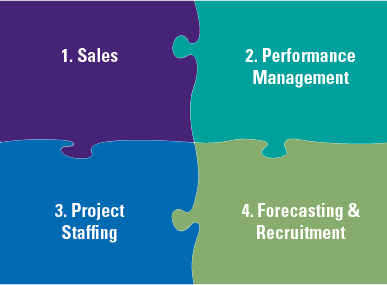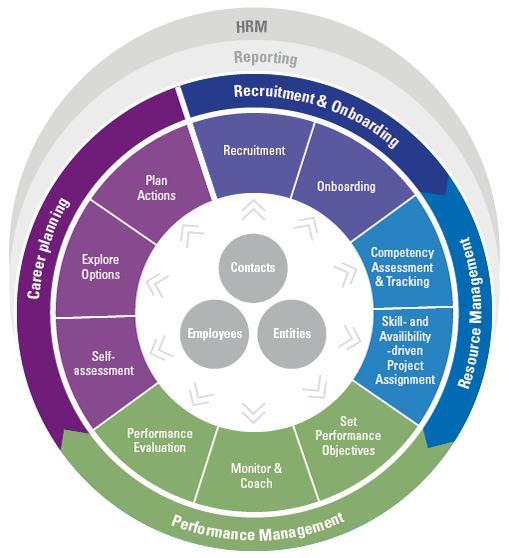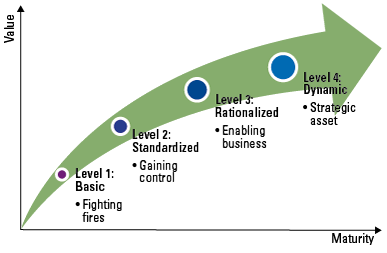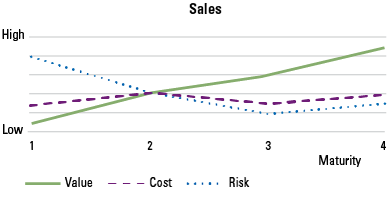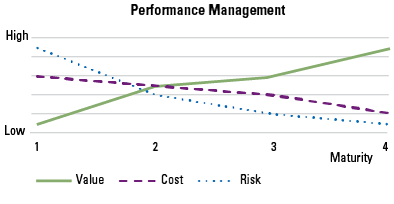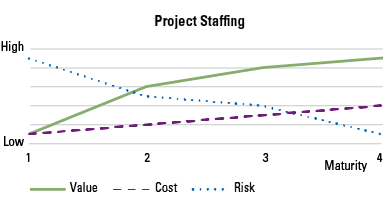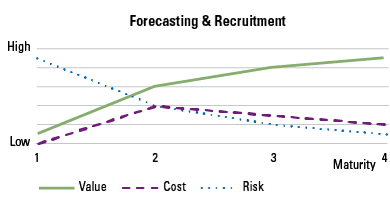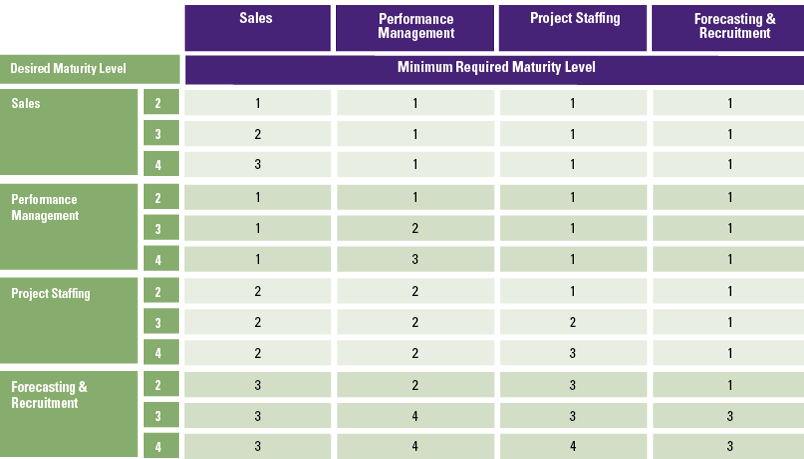Platform economies are surfacing in many industries. Directly linking supply and demand via a digital platform, the platform removes the need for intermediaries – making the search for services more efficient and transparent. The first examples of platform economies in HR are starting to appear. How can organizations that are often working on a project basis prepare themselves for this change? It requires maturity in a wide array of integrated capabilities – such as sales, recruitment and scheduling.
Introduction
In recent years, we could observe the rise of platform economies. AirBnB, eBay and Uber are well-known examples of companies providing platforms to bring supply and demand together – without owning the products that are being traded. Similar to the effect brokers had on markets such as housing, the retail market and taxis, disruptive forces may change the way we recruit and retain skilled resources. A trend sometimes referred to as the ‘gig’ economy, where short-term contracts and freelance work prevail over permanent jobs. It is a trend to be considered by HR departments, as the gig economy may enable new ways to acquire skilled resources.
Smart software solutions allow businesses to drive performance and automate business processes in the areas of growth, performance, risk and regulations using data. They can enable HR departments to respond to a changing world. At the heart of such solutions can be standalone software components or a combination of software components. For example, a successful SAP SuccessFactors implementation with a CRM system can be combined to form a smart software solution. Another example of smart solution is the extensible Microsoft Dynamics 365 platform, which allows organizations to execute Sales, Operations and HR processes.
This article explores how organizations with a predictable resource demand – e.g. because they work on a project basis – can prepare themselves for a gig economy by leveraging the capabilities of smart solutions and aligning them to business processes. The exploration is done via the introduction of the Employee Engagement Platform – a four-dimensional maturity model that aligns IT capabilities with business processes, focusing on obtaining engaged employees.
Employee engagement platform
The employee engagement platform helps organizations integrate Sales, Operations and HR in a sustainable manner that keeps employees engaged and aims at the timely availability of resources. This article focuses on the concepts and drivers of the engagement platform. The platform is underpinned by a four-dimensional maturity model that focuses on four domains: Sales, Performance Management, Project Staffing and Forecasting & Recruitment.
Figure 1. The employee engagement platform focuses on four domains. [Click on the image for a larger image]
1. Sales
Mature sales teams typically have a clear view on the status of the opportunities, so that a colleague can be replaced in case of absence or team changes. The clear view also enables the team to make reasonable predictions on the expected sales based on the opportunity pipeline. More opportunities can be created for the teams by optimizing the processes and leveraging social listening to identify opportunities via social networks.
In a sales cycle, there are many interactions with leads or customers. In addition to collaboration within the sales team, other departments may also be involved. For example, to provide input for the project estimates to give insights into the required budget. To capture all relevant details and to support the sales process, organizations typically make use of a CRM system. A well-used CRM system increases sales revenue by identifying the opportunities that have a good win probability and by giving the sales team insight into where they can improve their effectiveness.
2. Performance Management
Employees are the most important asset for many organizations. Ensuring that employees continue to develop themselves is pivotal to the long-term success of the organization. Keeping employees engaged is equally important, meaning that employees should spend the majority of their time performing to their strengths, which preferably overlaps with what they enjoy doing most.
Figure 2. The HRM Performance Wheel depicts major activities required to find new talent and invest in their growth. [Click on the image for a larger image]
The HRM Performance Wheel shows activities to align long term strategic company goals with the employee growth ambitions. It aims for continuous development and engaged employees, where the development of knowledge and skill is aligned with the company goals. The HRM Performance Wheel consists of 4 segments:
- Recruitment & Onboarding: revolves around effective finding, hiring and onboarding talent by tracking and streamlining recruitment investments and activities. While recruiting, a unified process ensures that applicants are contacted at the right time, with the right message and all recruiters know the latest status. These capabilities ensure that new hires are welcomed and onboarded in a consistent manner in line with the company standards.
- Resource Management: project delivery teams should be composed with resources that have the required skills and experience. Matching resources with projects requires that employee competencies are continuously tracked.
- Performance Management: for many organizations, setting and tracking goals is an important tool in measuring how an employee is performing. To facilitate performance management, HR professionals typically want to capture the evidence required for a fair and balanced performance review (including capturing recognition from peers and capturing internal and external feedback from managers and clients). The review outcomes should be captured and linked with clear follow-up steps for the employee. This is input for coaches to articulate potential development areas for their mentees.
- Career Planning: to keep employees engaged and growing in the direction where they can provide the most value to the organization, organizations would like to be supported in tracking short and long-term ambitions of their employees and use that knowledge to provide the right suggestions to them.
3. Project Staffing
Successful project delivery is the core business of many service-based organizations, thus it is important that every project is staffed with the right people. Selecting overqualified people sounds beneficial for the project outcome, but removes the challenge for those employees.
The challenge for the scheduling department is to find resources that are available at the right time to form skilled, well-balanced teams that match client needs. Ideally, the employee’s growth ambitions are also factored into the equation. This requires insight into resource utilization. When the required resources are not available, areas can be identified and managed where subcontracting may be needed.
Scheduling tools are extended with features to support a shift in initiative for project selection; instead of schedulers assigning employees to projects, employees select projects that align with their personal ambitions and personal circumstances. Sometimes they even select projects with an app, which can help keep employees satisfied in their job.
A good match between projects and resources can make it more fun to work on projects for both employees and contractors, creating an upward spiral that attracts new talent. Scheduling needs a support tool that enables them to proactively monitor and manage cost and utilization to keep billable resources utilized and to create the correct matches between projects and resources.
4. Forecasting & Recruitment
Predictive data analytics creates new synergy potentials for organizations that integrate the aforementioned domains Sales, Performance Management and Project Staffing. It provides insight into the gaps in resource skills required for projects and the availability of resources. Short term predictions of gaps are more reliable but require immediate follow-up actions to staff the projects. Gaps identified from long term predictions can be used as input for employee training plans and recruitment strategies to ensure that the right skills are available at the right time. Peaks in required resources can be anticipated and resolved using flex resourcing.
A detailed analysis of competencies and skills gives an insight into potential efficiency gains in the resource planning and resource training plans. A deeper analysis of the required skills and competencies can be used to suggest job profiles for recruitment, enabling organizations to find required resources in a short time frame. Significant organizational benefits such as reduced project lead time and maximized project outcomes can be achieved by proper resourcing.
Employee Engagement Platform Maturity Model
Being able to predict required resource requirements depends on the ability to:
- reliably forecast sales;
- accurately capture project resource requirements;
- have a clear picture on the availability of resources, their skills and expected career growth path.
Not every organization will be equally capable in each of those domains. Maturity models for each of the four domains can help in assessing the current state and next steps to reach the desired maturity level. The employee engagement platform uses a four-level maturity model for each of the domains, where the levels are depicted in Figure 3.
Figure 3. Four levels of maturity to classify the value of a business domain to the organization. [Click on the image for a larger image]
Based on our experiences with Microsoft Dynamics implementations, we outline how our employee engagement platform classifies each of the maturity levels in the four domains and highlight how the value, investment and risk varies throughout those maturity levels.
Sales Maturity
The employee engagement platform classifies sales maturity within organizations as follows:
- Level 1 (Basic): Organizations not using a CRM system or missing standardized sales processes. While having no or few costs for a supporting system, organizations typically spend (more) money on opportunities with a low win probability. Not properly being able to manage opportunities results in higher risk with minimal value; there may be longer periods without won deals, impacting the net result.
- Level 2 (Standardized): The sales department uses a CRM system and has collectively adopted standardized processes. Getting a better grip on the opportunities pays off in better opportunity qualification, allowing the organization to cut costs by preventing investment in opportunities that have a low win probability.
- Level 3 (Rationalized): Sales is able to produce a predictable sales pipeline through optimized sales processes.
- Level 4 (Dynamic): Organizations that leverage social capabilities of CRM solutions are able to identify and generate more opportunities. Some organizations prefer to start with social listening, but the real gains can be observed at organizations that engage with customers on social channels.
Figure 4. Value, Cost and Risk for Sales maturity levels. [Click on the image for a larger image]
Performance Management Maturity
The employee engagement platform classifies Performance Management maturity within organizations as follows:
- Level 1 (Basic): There are no consistently applied processes for HR such as recruitment, performance management and guidance to employees in their career to further develop their skills and competencies.
- Level 2 (Standardized): Standardized HR processes are embedded in the organization, leading to a uniform hiring and onboarding experience for new hires. Employees are rewarded for their effort through a fair process and support is in place to help them evolve professionally.
- Level 3 (Rationalized): When the HR processes are working effectively, employee feedback is considered, and employees are effectively guided in developing their desired skills and competencies. This leads to engagement scores that are higher than the industry average.
- Level 4 (Dynamic): Organizations are able to forecast employee attrition and predict developments in the skills and competencies of their employees.
Figure 5. Value, Cost and Risk for Performance Management maturity levels. [Click on the image for a larger image]
Project Staffing Maturity
The employee engagement platform classifies Project Staffing maturity within organizations as follows:
- Level 1 (Basic): Roles throughout the project lifecycle are unclear and/or resource assignment on projects is done on an ad-hoc basis.
- Level 2 (Standardized): Organizations have an overview of the required and assigned resources for running projects and are able to report on past and current resource utilization.
- Level 3 (Rationalized): Projects are planned using work breakdown structures, that are leveraged to assign resources for the upcoming period. The duration of that upcoming period is industry specific, where three months can be used as a starting point. Organizations are able to forecast the utilization for this period.
- Level 4 (Dynamic): Organizations are able to fully utilize resources and balance both internal and external resources for vacant function roles in work breakdown structures. They are also able to manage absence with low impact on the project outcomes and have a good understanding of their attrition.
Figure 6. Value, Cost and Risk for Project Staffing maturity levels. [Click on the image for a larger image]
Forecasting & Recruitment Maturity
The employee engagement platform classifies Forecasting & Recruitment maturity within organizations as follows:
- Level 1 (Basic): Organizations are unable to predict future resource requirements for the next quarter.
- Level 2 (Standardized): Resource underutilization is minimized by keeping most employees engaged above a healthy and sustainable utilization threshold. For the upcoming year – and at least on a quarterly basis – these organizations have a clear picture on which resources will be required.
- Level 3 (Rationalized): Based on the anticipated resource needs, job profile descriptions can be generated, and employees are trained/coached to meet the future required skills and competencies.
- Level 4 (Dynamic): Job profile descriptions are (semi-)automatically submitted to recruitment channels and online resource marketplaces. This can be used to fill permanent or temporary positions in anticipated capacity shortages. Organizations also have mechanisms in place for monitoring and are alerted if resource acquisition timelines are at risk.
Figure 7. Value, Cost and Risk for Forecasting & Recruitment maturity levels. [Click on the image for a larger image]
Maturity Model dependencies
The four different domain maturity models are linked to each other, as shown in Table 1. It leads to the following guiding principles:
- Sales and Performance Management can be developed independent of other business domains;
- To grow Project Staffing, a level 2 maturity in Sales and Performance Management is required;
- To grow in Forecasting & Recruitment, the organization needs to be mature in all other areas.
Table 1. To reach a desired maturity level in a domain, minimum maturity levels need to be met in all domains. This table depicts those dependencies. [Click on the image for a larger image]
Example: An organization wishes to be able to train its workforce to anticipate required skills for new deals that are reliably predicted to be landed within the next half year. This can be achieved with Maturity Level 3 in Forecasting & Recruitment.
The organization needs to meet the following preconditions:
- Sales level 3: to have a pipeline that can reliably predict new business;
- Performance Management level 4: to know when which employees leave, and which trainings are already planned;
- Project Staffing level 3: to predict utilization within the next half year;
- Forecasting & Recruitment level 2: the required foundation to start working on reaching level 3. Level 2 is demonstrated by a reliable resource utilization prediction.
Presort for a dynamic online resource marketplace
For some professions (such as carpenters, painters and IT experts), it is common that supply and demand meet via online platforms. Short and medium-term assignments are fulfilled by people who match the required skills. Ratings and recommendations from previous clients make the professional credible in that they are fit for the next job. It is a win-win for the professional and the client – the professional can find many opportunities that match his expertise, while the client can compare prices and experiences to find a good fit for their work.
With an increasing demand for highly educated and skilled resources, even organizations with a strong brand name experience difficulty in attracting, training and retaining talent. At the same time, the tendency of the latest generation to choose an employer for life has decreased. They change positions, so that they can learn more and/or choose to become self-employed.
In such a market, it becomes increasingly important for organizations to anticipate the required resource requests and to accurately describe the required skills in job profiles for the upcoming tasks. These job profiles can be used in a dynamic online resource marketplace to find candidates who are looking for a next opportunity and are available in the requested time frame. Not using such resource marketplaces may leave a potentially large source of skilled resources untapped.
Bottom line
The employee engagement platform guides organizations to implement a smart software solution that prepares them for the next platform economy that disrupts HR. The platform helps organizations assess how well Sales, Operations and HR are integrated, which enables them to identify the next steps required to reach their desired maturity level across these three domains. A mature HR department enables organizations to anticipate resources changes, predict resource needs and automatically generate accurate job profiles that can be submitted to the resource marketplace. This helps organizations reduce resource under-utilization and costs, while increasing agility. And most importantly; it helps them find resources in an increasingly competitive job market.




